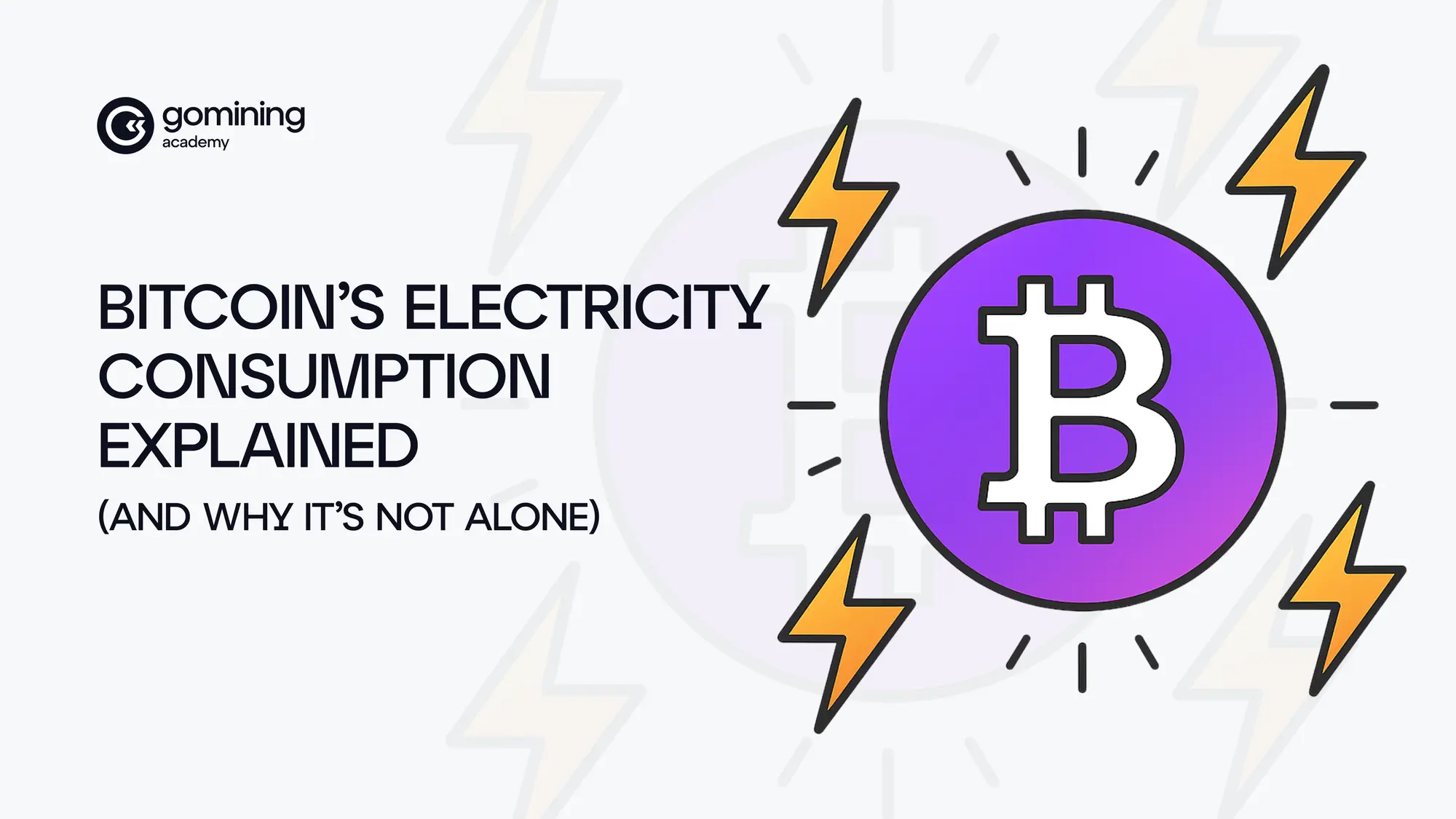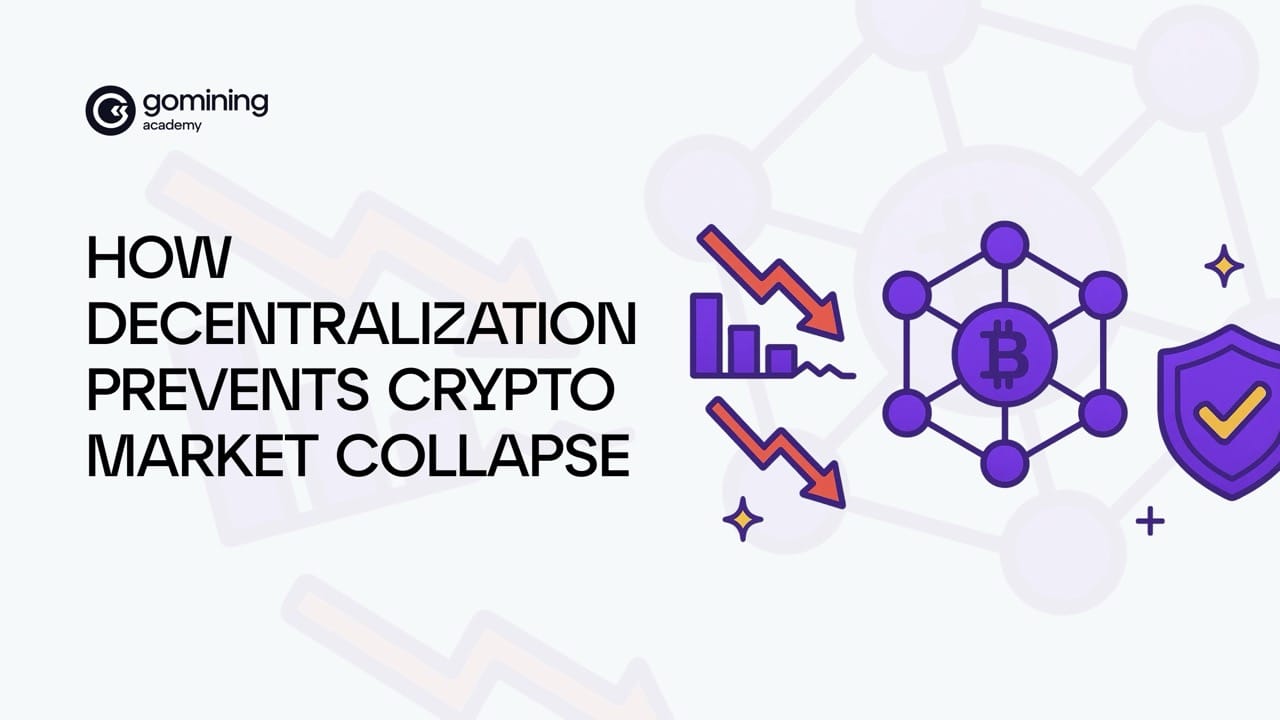Bitcoin’s Electricity Consumption Explained

Bitcoin: revolutionary, decentralized... and apparently, out to fry the Earth?
You’ve probably seen the headlines—“Bitcoin uses more electricity than Argentina!” or “One Bitcoin transaction could power your house for a month!”
The image is dramatic: rows of whirring machines, guzzling energy like it’s an all-you-can-eat buffet, belching heat and CO₂ into the sky. It sounds like the crypto apocalypse is nigh—and Bitcoin’s leading the charge.
But… is it really so? Is Bitcoin mining an ecological disaster in the making—or is this another case of misunderstood tech wrapped in clickbait?
In this article, we’ll separate the signal from the noise. We’ll break down:
- how much electricity does Bitcoin mining use
- Where that energy comes from (hint: not all of it is coal-fired doom)
- How it compares to traditional banking and gold mining
- And whether innovations like digital mining and renewable integration are changing the game
Because before we cancel Bitcoin for being power-hungry, maybe we should ask: what are we comparing it to—and what are we really paying for?
Table of Contents
- How Much Energy Does Bitcoin Use?
- Cryptocurrency Energy Consumption
- Bitcoin vs. Ethereum: Powerlifter vs. Pilates Instructor
- Proof of Work: Bitcoin’s Core Belief
- Critics of Bitcoin Mining Electricity Cost
- Traditional Banking vs Bitcoin Energy Consumption
- Lightning Network: Bitcoin’s Secret Weapon
- Bitcoin Energy Usage And Renewable Energy: A Synergistic Relationship
- From Blocks to Bots: Bitcoin Energy Use vs AI Power Hogs
- Bitcoin Energy Consumption Compared to Gold Mining
- GoMining: An Energy-Efficient Alternative to Traditional Bitcoin Mining
- Conclusion: Energy, Value, and the Bigger Picture
How Much Energy Does Bitcoin Use?
Bitcoin mining power consumption remains a prominent topic in global energy and environmental discussions. The most referenced assessment work on how much energy does Bitcoin use, is the Cambridge Bitcoin Electricity Consumption Index (CBECI), which estimates Bitcoin's annual electricity consumption to be around 193.30 TWh. This accounts for approximately 0.5% of the entire world’s electricity usage.
How much electricity does Bitcoin mining use per day, that will work out 481.8 GWh. Enough to power a large city for a year.
Bitcoin energy consumption compared to other countries’ annual electricity consumption

Although Bitcoin’s energy use is significant—roughly matching that of several mid-sized countries—it still represents only a small slice of the world’s rapidly growing electricity demand.
Broader trends in electrification and digitalisation add far more load to the grid. So much so, that they dwarf Bitcoin's total consumption. Bitcoin’s electricity consumption problem has been blown out of proportion.
Cryptocurrency Energy Consumption
Bitcoin is not the only crypto currency around. There are now many popular cryptocurrencies. Ethereum is another very well-established and popular cryptocurrency, which has been around for a while. However, even though Ethereum is a very popular and widely used cryptocurrency, Bitcoin’s energy consumption is much bigger. Let’s compare their crypto energy consumption.
☁️ Bitcoin vs. Ethereum: Powerlifter vs. Pilates Instructor
Ethereum: ~ 4.4 GWh/yearBitcoin: ~193 TWh/year(Yes—44,000 times more.)
Why the canyon-sized gap? Two words: Proof-of-Work.
Bitcoin runs on a system where miners solve ever-harder puzzles to validate transactions. Think of it as a global Sudoku deathmatch where the more people join, the harder the puzzle gets.
Instead of solving energy-hungry puzzles like Bitcoin, Ethereum now uses a system called Proof of Stake. Picture it like owning shares in a network. When you "stake" your ETH, it's like buying shares, which gives you a chance to help validate transactions and secure the network.
The more ETH "shares" you hold, the greater your opportunity to be chosen for this task and earn rewards. Essentially, your earnings are proportional to your share of the staked coins in the network, making it a system where participants are rewarded based on their commitment.
So why hasn’t Bitcoin followed suit?
🔐 Proof of Work: Bitcoin’s Core Belief
Bitcoin didn’t just accidentally pick Proof of Work (PoW) like someone blindly clicking a checkbox during setup. It chose it because PoW embodies everything Bitcoin stands for:
1. Skin in the Game
Miners must commit real resources—electricity, hardware, risk. You can’t fake it. That’s what makes Bitcoin trustless: you trust the cost, not a person.
2. Security Through Sacrifice
Trying to hack Bitcoin is expensive. You’d have to outspend the majority of honest miners just to rewrite the ledger. That’s not inefficiency—it’s armor.
3. Fair Launch, Fair Play
There were no behind-closed-doors discounts for rich friends or investors. Think of a concert where all tickets went on sale to the public at the same time—no VIP line sneaking in early.
4. Decentralization by Design
With PoW, your influence comes from your hashpower, not your wallet size. It’s not about who you are—it’s about what you contribute. Many argue that what makes Bitcoin stand for Decentralization is its proof of work protocol, because it ensures that the system is almost impossible to be rigged by an outsider.
PoW is hard. On purpose. Because money that’s hard to make is harder to corrupt.
💡 Why Not Switch to Proof-of-Stake?
Because that’s not what Bitcoin is.
PoS is efficient, sure—but it’s capital-based, not effort-based. The more coins you have, the more power you get. It’s... elegant, but it also resembles the system Bitcoin was built to replace: one where the rich get richer just by showing up.
Bitcoin says:
“You want to participate? Put in the work. Burn the energy. Take the risk.”
🧱 In Short:
Proof of Work = Proof of Commitment.
It’s hard. It’s costly. It’s beautifully inefficient by design. Because Bitcoin isn’t just digital money—it’s a rebellion wrapped in code. 💣
⚔️ Critics of Bitcoin Mining Electricity Cost

- Proof of Work is a gritty gym. You sweat, you strain, you earn every rep. Nobody can fake muscle here. It is pure Bitcoin power!
- Proof of Stake is a VIP lounge. You’re in because you have money. No workout required. Yes, there is less crypto energy, but less crypto power to the people.
Traditional Banking vs Bitcoin Power Consumption
In a paper by Michel KHAZZAKA, Khazzaka makes a comparison between the power consumption of Bitcoin and that of traditional banking. In the paper he estimates that the overall energy consumption of the traditional banking sector, which Bitcoin is trying to replace, is estimated to be 2,252.75 TWh/yr that is roughly 12 times more than the energy consumption of Bitcoin. He does this by examining the power consumption of each sector in the banking system and seeing how much energy it consumes.

Lightning Network: Bitcoin’s Secret Weapon
Michel KHAZZAKA also mentions the Lightning network which is an eloquent technological solution to lower Bitcoin's energy consumption and speed up its transactions. The Lightning Network acts as an extra speed lane on top of the Bitcoin Blockchain. This way, it allows for millions of fast, low-energy transactions off-chain, and only settles final balances on the blockchain.
The lightning network is gaining popularity and is being adopted by many users. Should it be properly established it could make Bitcoin even more efficient than the banking sector.
Bitcoin Energy Usage And Renewable Energy: A Synergistic Relationship
While Bitcoin mining is often scrutinized for its energy consumption, an emerging trend showcases its potential alignment with renewable energy initiatives. Miners are increasingly co-locating operations with renewable energy sources—such as wind, solar, and hydroelectric facilities—to utilize surplus or stranded energy that might otherwise go to waste. This approach not only provides a consistent demand for renewable energy producers but also enhances grid stability by acting as a flexible load that can adjust based on energy supply and demand dynamics. For instance, in regions like Texas, miners participate in demand-response programs, powering down during peak grid stress and ramping up when renewable output is abundant, thus smoothing load curves and reducing reliance on fossil-fuel peaker plants. Additionally, countries like Pakistan are allocating significant electricity capacity to Bitcoin mining and AI data centers to effectively utilize unused energy resources. By integrating with renewable energy infrastructures, Bitcoin mining not only mitigates its environmental footprint but also contributes to the broader adoption and economic viability of clean energy solutions.
💻 Digital and Cloud Mining: Efficiency Without the Hardware Hassle
For those who want to support Bitcoin’s network without the hassle of running energy-hungry machines, digital and cloud mining offer efficient alternatives. These platforms allow users to purchase mining power hosted in professional data centers—often optimized for energy efficiency and located near renewable energy sources. By aggregating demand and centralizing operations, cloud and digital mining reduce overhead, streamline energy use, and make mining more accessible to individuals who might not have the resources or technical know-how to run rigs themselves. It’s a hands-off way to participate—minus the noise, heat, and electricity bill.
From Blocks to Bots: Bitcoin Energy Use vs AI Power Hogs
The digital age runs on data—and data centers are guzzling electricity like never before. The rise of artificial intelligence (AI) has turbocharged this trend, driving a surge in global energy demand that’s rewriting the rulebook.
In 2024, global data center consumption hit 415 TWh, roughly 1.5% of the world’s electricity use. By 2030, that number is projected to more than double to 945 TWh. For 2025 alone, Deloitte estimates data centers will consume 536 TWh, accounting for 2% of global demand.
Zoom in on the U.S., and the picture gets even wilder: by 2025, American data centers could draw 224 TWh, or about 5% of the country’s total electricity consumption—with projections rising to 606 TWh by 2030.
The culprit? Generative AI. These models are brilliant, but they’re thirsty—5 to 10 times more power-hungry than traditional computing systems. Supporting them may require an extra 50–60 gigawatts of new infrastructure worldwide.
All this to say: Bitcoin isn’t the lone energy hog it’s made out to be. It’s part of a much bigger digital ecosystem—one that’s growing fast and demanding more power at every turn. If we’re serious about sustainability, our energy policies need to focus on the entire digital infrastructure—not just the blockchains making headlines.
Bitcoin Energy Consumption Compared to Gold Mining
Gold's high price isn't solely due to its rarity; it's also a reflection of the immense effort and energy required to extract it from the earth. Estimates suggest that gold mining consumes approximately 131 TWh per year, a figure that surpasses the total electricity consumption of countries like New Zealand . This substantial energy demand translates directly into significant operational costs, further contributing to gold's high market value.
However, it is worth mentioning that beyond energy consumption, gold mining poses serious environmental and health risks. The industry often relies on toxic substances such as mercury and cyanide to extract gold from ore. Mercury, used predominantly in artisanal and small-scale mining, can contaminate water sources and bioaccumulate in the food chain, leading to severe health issues in humans and wildlife . Cyanide, commonly used in large-scale operations, is highly toxic and has been responsible for catastrophic environmental disasters, including massive fish kills and long-term water pollution . While gold itself is not inherently toxic, the processes employed to extract it can have devastating consequences for ecosystems and communities.
In contrast, Bitcoin mining, while also energy-intensive, operates without the use of hazardous chemicals. Estimates of Bitcoin's annual electricity consumption around 193 TWh per year, placing it comparatively higher than gold mining. However, Bitcoin mining's environmental impact is primarily associated with its carbon footprint and electronic waste, rather than chemical pollution.
While both gold and Bitcoin mining have significant environmental footprints, the nature of their impacts differs. Gold mining's environmental challenges are rooted in chemical pollution and habitat destruction, whereas Bitcoin mining's concerns center around energy consumption and associated carbon emissions. Efforts to mitigate these impacts are ongoing in both industries, with initiatives aimed at reducing energy consumption and transitioning to more sustainable practices.
GoMining: An Energy-Efficient Alternative to Traditional Bitcoin Mining
If you know how to mine Bitcoin, then you are aware of the challenges that lie ahead of anybody who wants to be a Bitcoin miner. Investing in large energy efficient Bitcoin mining machines is a major cost and financial hurdle. As well as trying to keep up any possible environmental regulations regarding Bitcoin mining in your region.
GoMining offers a refreshingly straightforward gateway to Bitcoin mining by offering the option of digitally mining Bitcoin. But how profitable is Bitcoin mining? You can compare purchasing hardware versus leasing it online in the candid breakdown “Digital Miner vs Cloud Mining” and sanity-check your ROI expectations.
This article on how to choose a Bitcoin mining app will help you decide the best path for you, if you want to explore the digital mining route. Because even in this mad, crazy crypto cosmos, informed decisions never go out of style.
If you decide to use GoMining’s slick Bitcoin mining app, you can pick from an ever-growing list of vetted GoMining hashpower providers ready to fuel your rigs. Then you can browse its curated lineup of NFT plug-and-play Bitcoin Miners and themed GoMining digital miner collections. With GoMining avatars, you can personalise your mining strategy by choosing unique NFT miners that deliver real Bitcoin rewards.
Run the platform’s no-nonsense Bitcoin mining calculator to see exactly how much hashpower you can squeeze out of every satoshi.
Prefer to stack tokens instead of ASICs? Seasoned miners can deep-dive into the tech behind the GoMining token. This is the platform’s heartbeat, which is all part of GoMining’s complete and detailed crypto tokenomics environment. Use these tokens to get voting rights, pay for maintenance fees,
For those who like their crypto quests gamified and are into Bitcoin mining games, the cosmic-scale Miner Wars metaverse turns hashrate into a high-stakes strategy. While their GoMining VIP rewards program unlocks bigger discounts and accelerated payouts. Furthermore you can boost your earnings by up to 5% by joining GoMining’s crypto referral program, which rewards you for bringing in new users.
🔚 Conclusion: Energy, Value, and the Bigger Picture
Yes, Bitcoin consumes a lot of energy—but so do banks, gold mines, and the servers powering your favorite AI chatbot. What sets Bitcoin apart isn’t just how it spends electricity, but what it’s building in return: a decentralized, borderless financial system that doesn’t ask for permission.
Its Proof of Work mechanism isn’t a flaw—it’s a feature. A costly one, yes. But that cost is what secures the network, levels the playing field, and resists corruption.
Critics often isolate Bitcoin in the energy conversation. But when we zoom out, we see a world where AI, banking, and commodities all come with their own invisible power bills. If we’re going to talk about sustainability, we need to talk about all of it—not just the parts that make headlines.
In the end, the question isn’t whether Bitcoin uses energy. It’s whether what it offers is worth the energy it uses. And for millions of people seeking sovereignty, transparency, and freedom—it just might be.


